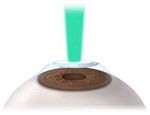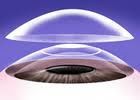WHAT IS PRK?
Photorefractive keratectomy (PRK) is a laser assisted surgical procedure using the excimer laser to correct refractive error. PRK involves the removal of a thin layer of epithelial tissue from the cornea, followed by the excimer laser permanently changing the optical power of the eye. Once the laser is applied the removed epithelial cells need to regenerate. A bandage contact lens placed on the eye for four days aids in the cells regenerating and healing.
PRK has the same visual outcome as LASIK, however the recovery process is slower and there will be a period of discomfort during the first 4 days after surgery.
HOW IS PRK PERFORMED?
-

Part I: Instrument used to prepare the corneal surface for laser.
-

Part II: Excimer laser is used to reshape the cornea.
-

Part III: Bandage contact lens is placed over your eye to allow healing.
ON THE DAY OF THE PROCEDURE
Do not wear any form of make-up, powder or perfume on the day of your procedure.
You can not drive yourself home on the day of your surgery, please arrange for someone to take you home.
Plan to be at the surgery centre for 1 - 1.5 hours, the actually procedure takes 20 minutes for both eyes.
- Local anaesthetic eye-drops will be placed in your eye to ensure you experience no pain during PRK.
- A sedative tablet is often given prior to surgery.
- You will be placed under the Excimer Laser and your head will be positioned directly under the laser.
- A sterile dressing will be placed over your face exposing only the eye to be treated.
- A speculum will be placed between your eyelids to open your eye and prevent blinking and a clear, adhesive plastic film will be placed over your eye to hold down your eyelashes.
- Doctor will ask you to fix your focus on a blinking light, while he prepares the corneal surface.
- Once the doctor has done this the laser will begin reshaping your cornea. You will hear a rapid "clicking" sound and see a bluish white light rapidly flashing. You will also smell the scent of burning hair or similar. At some moments you may not see the fixation light but you should keep your eye as still as possible. However, if you do move your eye accidentally, the laser will stop and restart once you have regained fixation.
- When the cornea reshaping is done, Doctor will put some more drops in, then cover the treated surface with a contact lens.
AFTER YOUR SURGERY
- Your vision will be blurry and fluctuating for the first four to five days.
- You will be in quite a bit of discomfort for up to 4 days, with some improvement as each day passes.
- You SHOULD NOT remove the contact lens yourself. This will be done at your 4 day post operative visit. Follow the instructions you are given and instil all drops on top of contact lenses.
- Pain killers will be essential and these are provided to you. Feel free to use your own form of pain management if you choose.
- You will be light sensitive and feel much better with your eyes closed – do this as much as you can especially for the first 24-48 hours.
- Cold compress on your eyelids and resting in a dimly lit room are also quite helpful.
- Taping bandages over your eyes is not essential but sometimes the pressure of this can help to suppress the discomfort.
- You will notice your vision gradually improving over the first week and especially after having your contact lenses removed on the fourth day after surgery.
For the first two weeks after your procedure, please don’t rub your eyes, don’t go swimming, don’t wear eye make up and please avoid dusty environments, contact sports or long overseas air travel.
Work: You can generally return to work 5 days after the PRK procedure.
Driving: You can normally drive 5 days following your PRK procedure, at your 4 day post operative check we will inform you when it is safe for you to drive.
Follow up appointments
- Day 1 – vision check and review of pain management
- Day 4 – removal of contact lenses
- 2 weeks post op – review with doctor
- 2 months post op – review and discharge


 n
n